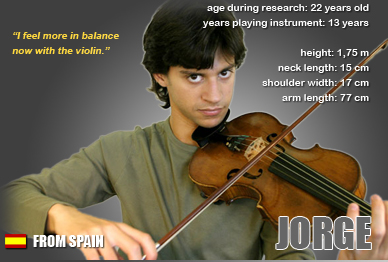4. What worked for me
Violinists and Balance
I think that the right equipment helps you keep your balance, but it doesn’t make you balanced. That’s my opinion. It is very easy for me now to change my equipment because I have a bit clearer idea of what balance is. I would call this research something like: “How to learn where to find your balance.”
In the Alexander Technique lessons I learned many things about walking and standing and how to sit and about how everything has to go “up.” This was something that I misunderstood from the instructions of all my violin teachers that “You have to go down to feel your violin.”* I interpreted it the wrong way because I was pushing allmy muscles and all myself down and it didn’t help my playing. Now I know a bit more the “up feeling.”** When I go “up”, I still can feel the contact with my violin but the feeling of pressure pushing down on my chest is gone.***
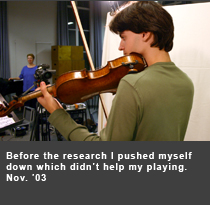
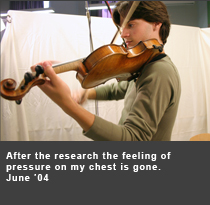
My playing is better, much better, because of the more balanced use of my body. My perceptions of my playing and myself changed, not only with my violin but with everything in my life. For instance, I think sometimes about how I am moving also when I am cooking. These basic things helped me to perceive what violin playing is.
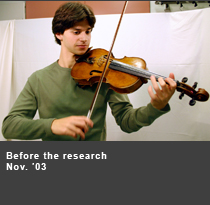
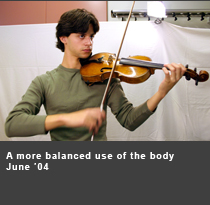
There are three or four basic things that are “musts” for fitting the equipment. I would like to use them with my students in the future. One is “put the violin on the collar bone.” The next is to use your eyes to look up and around the room to free your neck. Then to notice the space between your collar bone and your jaw and try to fill it a bit with the chin rest. Of course the equipment is very important, but without the Alexander Technique I couldn’t use it. I would also like to teach my students a lot about balance. These few things are “inviolable;” they are the basics.
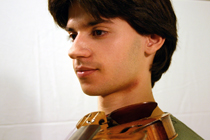
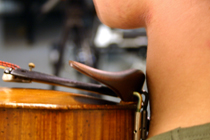
Put your violin on your collar bone, then take a look at the space between your chin rest and your jaw. (Me with my old chin rest, Nov. ’03)
I think we violinists also have a challenge to our balance because our playing all happens up above shoulder level. Everything is happening up there. It’s easy to feel no contact with the ground. I like to use the balance board to stand on while I play. I also put a beanbag on my head to remind me where my head is. During the research year, I kept up my daily work trying to feel, to find the balance. I did this mostly at the beginning of the day, while playing scales. It was much more than just doing technical exercises. Just feeling – trying to feel everyday more and more clearly what you are doing. I think this work should go on forever. I don’t believe that this is something that you can stop, that you just get good at it. It is something that you walk toward but you never reach. And I will not stop walking.
*Jorge may be referring to a common instruction to use the weight of the arm to facilitate contact of the bow on the string.
**By “the up feeling” Jorge is referring to the feeling of lightness that students who study the Alexander Technique often remark upon.
*** “Going up” is a term used in Alexander Technique lessons that describes the lengthening of the stature that results when habits of shortening are prevented.

